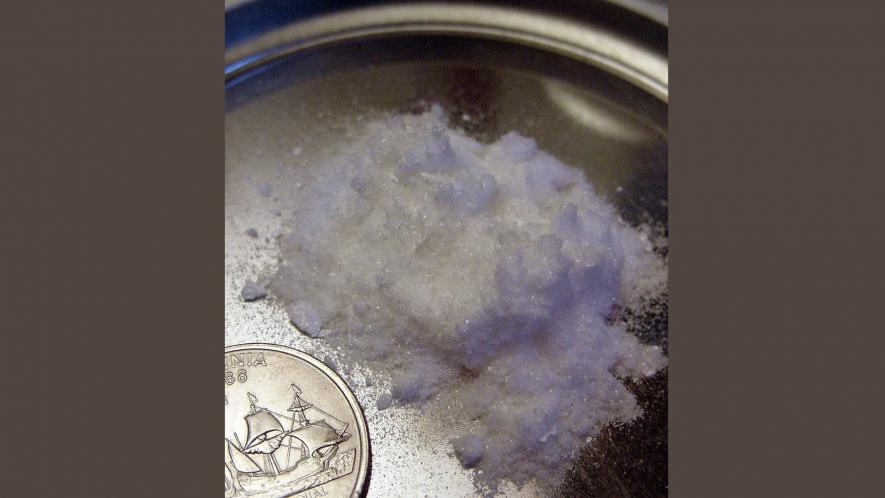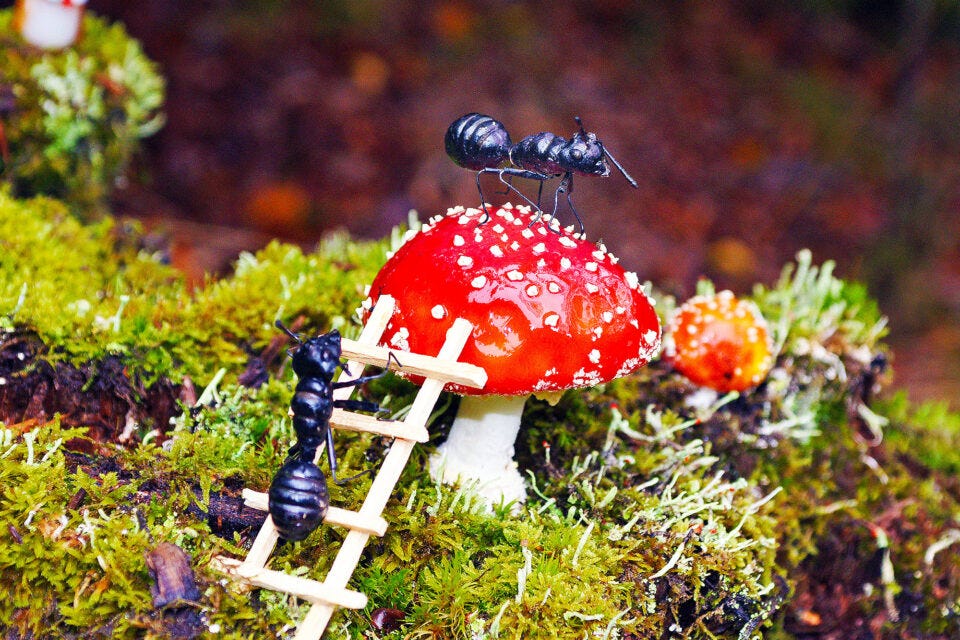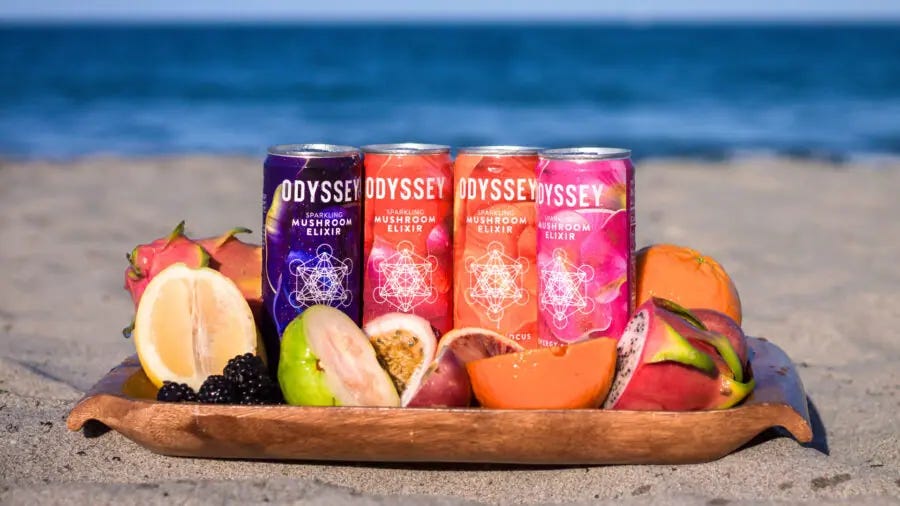Psychedelics, Fungi, and the Future of Energy Drinks
Fungi Friday's - June 23rd, 2023 - Issue #85
Happy Fungi Friday,
And welcome back to another issue of your favorite fungi focused corner of the internet. It’s officially summer, can you believe it? Fun fact, in the gym this week, I learned that summer not only officially has a start date (June 21st), but it also has a start time (9:58 am CST — at least this year). Crazy, huh? That’s enough useless knowledge for one newsletter though, let’s get into the useful stuff!
In today’s email:
Can psilocybin reopen critical learning centers in the brain?
Farmer ants; the hardest workers in the garden
How fungi are transforming the energy drink industry
Iowa Fungi’s Update of the Week
Talked to the power company this week again, and supposedly “they’re working on it” — where have I heard that before? Oh yeah… the driver that was supposed to move the trailer. That’s alright, sometimes these things take time… and quite honestly, at this point, it’s almost the holiday weekend, so we’ll probably plan to just get things going after that. So plan for another nothing-burger of an update from me next week… i’ll be traveling again. Is what it is, let’s get into the stories!
Psychedelics reopen the social reward learning critical period
A new study published in Nature found that psychedelic drugs can reopen a critical period for learning about social rewards. This means that adults who take psychedelics may be able to learn to associate social cues with rewards, even if they were unable to do so as children.
The study was conducted on mice, and the researchers found that the effects of psychedelics on social reward learning lasted for several weeks. They also found that the longer the effects of the drug lasted, the longer the critical period remained open.
The researchers believe that the reorganization of the extracellular matrix, a structure in the brain, is a common mechanism through which psychedelic drugs reopen the critical period. This finding could have implications for the use of psychedelics in clinical practice and the development of new compounds for the treatment of social disorders.
Here are some of the key takeaways from the study:
Psychedelic drugs can reopen a critical period for learning about social rewards.
This means that adults who take psychedelics may be able to learn to associate social cues with rewards, even if they were unable to do so as children.
The effects of psychedelics on social reward learning lasted for several weeks.
The longer the effects of the drug lasted, the longer the critical period remained open.
The reorganization of the extracellular matrix, a structure in the brain, is a common mechanism through which psychedelic drugs reopen the critical period.
This study is still in its early stages, but it has the potential to revolutionize our understanding of how psychedelic drugs work and how they can be used to treat social disorders.
Stay tuned for more research on this topic in the coming years.
Psychedelic Spotlight
Fungus farming ants work hard to maintain healthy gardens
Some ants are not content to just eat leaves and insects. They've evolved to farm fungi, and they work hard to keep their gardens healthy.
Leafcutter ants are one species of fungus-farming ant. They collect leaves and transport them back to their nests, where they cut them into small pieces and use them to grow a specialized type of fungus. This fungus is the ants' primary food source, and they work tirelessly to protect it from pests and mold.
The ants also have to weed their gardens regularly. They remove any leaves or fungus that is not healthy, and they even have a way of detecting diseased fungus by its smell. This allows them to quickly remove the infected fungus before it can spread to the rest of the garden.
Fungus-farming ants are some of the most industrious creatures on Earth. They work hard to provide for their colony, and their efforts have helped them to thrive for millions of years.
Here are some of the key takeaways from the article:
Some ants farm fungi as their primary food source.
Leafcutter ants cut leaves into small pieces and use them to grow a specialized type of fungus.
The ants work tirelessly to protect their gardens from pests and mold.
They even have a way of detecting diseased fungus by its smell.
Fungus-farming ants are some of the most industrious creatures on Earth.
This article is a great reminder that even the smallest creatures can be incredibly industrious.
If you're ever feeling lazy, just remember the leaf-cutter ants and their hard work.
More Mushroom Mentions
What It Looks (And Smells) Like When Mushrooms Hunt Nematodes
Mushrooms Are The Beauty World's Muse This Year - Here's How To Use It In Your Skincare Routine
Fungi in the “New Age” of Functional Energy Drinks
Functional energy drinks are a growing market, and fungi are becoming a popular ingredient.
There are several reasons for this. First, fungi are naturally rich in antioxidants and other nutrients that can boost energy levels. Second, fungi have been shown to have adaptogenic properties, which means they can help the body adapt to stress and improve overall health. Third, fungi are a sustainable ingredient that can be grown without the use of pesticides or herbicides.
Some of the most popular fungi used in functional energy drinks include chaga, reishi, and cordyceps. Chaga is a type of mushroom that has been used for centuries in traditional Chinese medicine. It is rich in antioxidants and has been shown to boost the immune system. Reishi is another type of mushroom that has been shown to improve sleep quality and reduce stress levels. Cordyceps is a type of fungus that is native to the Himalayas. It is known for its ability to improve athletic performance and endurance.
The use of fungi in functional energy drinks is still in its early stages, but it is a trend that is likely to continue to grow. As more research is conducted on the health benefits of fungi, we can expect to see even more innovative products on the market.
Here are some of the key takeaways from the article:
Fungi are becoming a popular ingredient in functional energy drinks.
There are several reasons for this, including the fact that fungi are naturally rich in antioxidants and other nutrients, have adaptogenic properties, and are a sustainable ingredient.
Some of the most popular fungi used in functional energy drinks include chaga, reishi, and cordyceps.
The use of fungi in functional energy drinks is still in its early stages, but it is a trend that is likely to continue to grow.
This article is a great introduction to the world of functional energy drinks and the role that fungi can play in them.
If you're looking for a natural way to boost your energy levels, consider trying a functional energy drink that contains fungi.
That’s all, folks… but before we let you go, leave a comment below on how we can make the publication even better! And if you haven’t yet, smash that SUBSCRIBE button below.
Thanks for reading as always,
BowTiedMushroom




